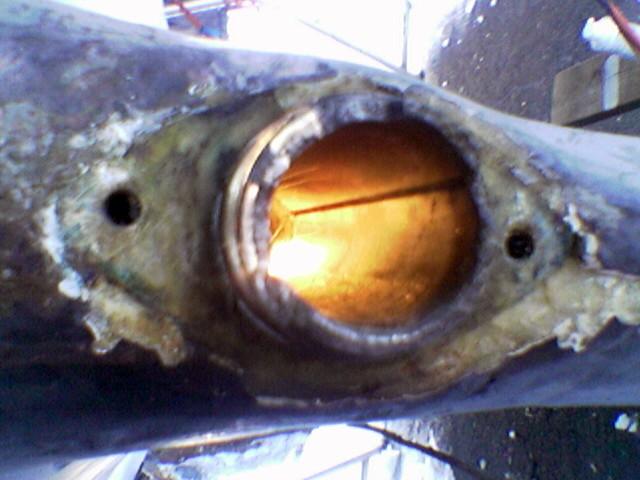Welcome Back › Forums › Propulsion › Steering and Rudder › Cutless bearing
- This topic has 10 replies, 3 voices, and was last updated 3 years, 3 months ago by
 Moderator.
Moderator.
-
AuthorPosts
-
November 15, 2021 at 08:11 #27064
Rhapsode
ParticipantHas anyone replaced the white metal bearing with a cutless bearing?
November 15, 2021 at 16:56 #27065 ModeratorKeymaster
ModeratorKeymasterWe have not, but I am wondering if you saw this earlier posting about a vendor-offered Maritex solution to the white metal bearing replacement problem:
November 15, 2021 at 21:47 #27066Rhapsode
ParticipantThanks Marilyn,
I’m struggling to find the drawing of the shaft and the bearing using the plans’ archive. I’m wondering if there is any reason why a cutless bearing can’t be used?
PeterNovember 19, 2021 at 23:15 #27067 Arild JaegerParticipantNovember 19, 2021 at 23:19 #27068
Arild JaegerParticipantNovember 19, 2021 at 23:19 #27068 Arild JaegerParticipantNovember 19, 2021 at 23:20 #27069
Arild JaegerParticipantNovember 19, 2021 at 23:20 #27069 Arild JaegerParticipantNovember 20, 2021 at 00:07 #27070
Arild JaegerParticipantNovember 20, 2021 at 00:07 #27070 Arild JaegerParticipant
Arild JaegerParticipantThe white metal was moulded into the stern tube. There needs to be a bit of clearance between the white metal and the tail shaft. Also pathways or grooves for the grease to pass through the bearings must be made (see photos).
November 20, 2021 at 00:09 #27071 Arild JaegerParticipant
Arild JaegerParticipant November 20, 2021 at 00:12 #27072
November 20, 2021 at 00:12 #27072 Arild JaegerParticipant
Arild JaegerParticipantWhite metal bearings are made from white metal alloys, which can include tin, lead, zinc, and bismuth. Of course, each white metal bearing will contain a different combination of alloys, depending on the desired strength and other requirements. White metal bearings are beneficial in that they offer an extended service life under normal operating conditions. When it comes to excess momentary overloads, these bearings also perform well. When there is an alignment or lubrication problem, the white metal bearing can compensate with greater ease than other types of bearings.
The alloys used in white metal bearings are also called Babbitt metals. These metals have a low melting point and offer very good resistance to friction. The alloys included in the bearing makeup will determine what applications the bearing is best suited to.
Many people incorrectly assume that, because white metals are considered a soft material, that they are unsuitable for the manufacture of bearings. However, the soft material incorporates hard crystals which, over time, create groove paths in the material which, in turn, provide the ideal conditions for effective lubrication of the bearing.
(Source: http://www.technoslide.com/bearing-white-metal.html)
November 20, 2021 at 20:42 #27073Rhapsode
ParticipantThanks Arild, that’s very helpful. I’ll pass the information onto the engineers and see what they make of it. They are still wanting to fit a standard cutless bearing but this might make them change their mind. The boat is in Grenada and I’m told no one is familiar with white metal bearing in yachts. They don’t often see 50 year old boats.
November 22, 2021 at 21:25 #27074 ModeratorKeymaster
ModeratorKeymasterI can second Arild comments, and advise that you keep looking for someone who knows about white metal.
We were able to find someone in Port Townsend Washington, USA to make us a new white metal bearing, and it was the right way to go. You can find details on our personal blog.
You can find a PDF copy of the C&N original dimensioned drawing and install information already posted (with permission from Jeremy Lines) on this website here.
Marilyn, moderator
-
AuthorPosts
- You must be logged in to reply to this topic.